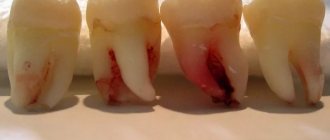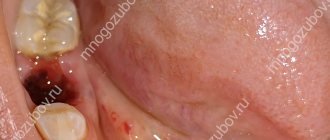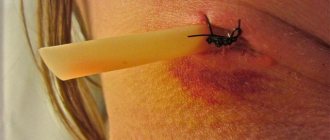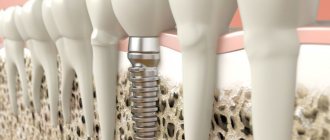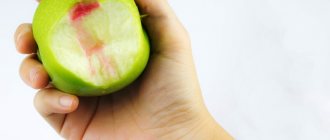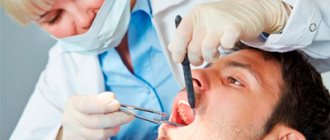Tooth extraction is a type of surgical intervention. The consequences of this operation may vary. Many people worry about the resulting wound. How long does it take for the affected area to heal, when will the bleeding stop and how often is ichor released after tooth extraction are some of the most exciting questions for patients. To prevent the development of complications, it is necessary to properly care for the resulting wound.
Sukrovitsa - f. Yellowish fluid that flows along with blood from the affected areas of the body, as well as bloody fluid that flows from abscesses and ulcers. Modern explanatory dictionary of the Russian language by Efremova
To prevent the development of complications after tooth extraction, it is necessary to properly care for the resulting wound.
Characteristic symptoms after tooth extraction (extraction)
During the process of tooth extraction, inevitable damage occurs to soft tissues, blood vessels, mucous membranes, nerve endings and other matters involved in holding the tooth. At the end of the operation, a natural inflammatory process develops, which is accompanied by various symptoms. Among which stand out:
- bleeding, the duration depends on various factors, can last from thirty minutes to three hours after tooth extraction;
- pain at the site of tooth extraction, which may be accompanied by pain in nearby teeth and even organs;
- swelling of the affected area;
- clearly defined redness of the mucous membrane at the site of the excluded tooth;
- possible increase in temperature;
- discomfort when moving the jaw.
The above signs are considered normal manifestations after tooth extraction. The inflammatory process decreases as the affected area is restored. As a rule, this takes from four to seven days . If an infection enters the body, the wound healing process is delayed and it is necessary to take medications.
In the place of the excluded tooth, a hole is formed that has sufficient depth, which is due to the long root system of the tooth. After bleeding stops from the site of tooth extraction, a blood clot forms, which promotes wound healing and prevents harmful bacteria from entering. If bleeding continues from the formed hole after tooth extraction for more than three hours, you must contact your doctor to take the required measures. This may include prescribing special medications, suturing the affected area, or using a hemostatic sponge.
Signs of inflammation
The inflammatory process in the socket occurs when a blood clot is damaged and the wound becomes infected. The following signs indicate its development:
- pain of varying intensity - aching, throbbing,
- fatigue and severe weakness,
- rise in temperature to subfebrile levels,
- unpleasant odor and taste in the mouth,
- pain when touched, contact with hot and cold,
- discharge of pus,
- difficulty chewing, swallowing, opening the mouth.
With alveolitis, the socket may become dry and a greenish or yellowish coating may form. If a blood clot falls out and pain occurs, do not put off visiting the dentist. It is easier to stop the inflammatory process at its beginning. The doctor will curettage the hole, treat the wound with an antiseptic solution, and prescribe antibacterial drugs.
Causes of ichor after tooth extraction
Associated factors influencing the duration of ichor discharge after tooth extraction:
- damage to blood vessels;
- inflammatory reaction in damaged tissues;
- hypertensive crisis;
- poor blood clotting indicators.
When a patient has hypertension, the risk of severe bleeding from the site of the extracted tooth increases. This is due to taking medications that lead to blood thinning. Experts recommend stopping taking such medications a couple of days before the planned surgery.
Also a dangerous factor is the presence of low blood clotting in the patient. In this case, it is recommended to take a course of sedatives to prevent surges in blood pressure.
Scope of application
Enriched fibrin is officially recognized as a drug with an effective effect in healing and regeneration after surgery. One of the areas where the drug is used most actively is dentistry. Membranes show excellent results in implantation, treatment of soft tissues, and bone restoration.
Areas of use:
- in case of complex tooth extraction, if there is a need to preserve bone volume, alveolar walls, and prevent complications;
- to prevent gum recession (the drug is applied to the exposed necks, preventing further deterioration);
- to perform preimplantation augmentation, including in case of hard tissue deficiency;
- as a coating for artificial roots during implantation (used to accelerate the integration of the implant into the bone);
- during closed or open sinus lifting;
- for immediate implantation, to stabilize the rod after screwing in;
- performing patchwork surgical interventions, including recession of gum tissue, sinus lifting, elimination of various types of defects, wound therapy;
- rapid healing during maxillofacial plastic surgery, prevention of complications.
Caring for the socket of an extracted tooth
After tooth extraction, to prevent the development of complications and reduce the secreted ichor, as well as to speed up the healing of the wound, it is necessary to properly care for the resulting hole. To do this, you should adhere to the following recommendations:
- Hold the tampon with the medicinal substance applied by the dentist for thirty minutes;
- If a blood clot forms in the socket, it is not recommended to rinse it, spit it out, or remove it by other methods during the day;
- Do not disturb the damaged area by palpating with your tongue or other means;
- Do not chew food with the place where the tooth was removed, and do not suck any drinks through a straw for 24 hours;
- Limit or completely eliminate heavy physical activity;
- Avoid visiting bathhouses, saunas, taking hot showers and prolonged exposure to sunlight for a day;
- The use of warming compresses in the area of tooth extraction is prohibited;
- For three hours after surgery, you must stop eating;
- To avoid the development of swelling and pain, it is necessary to eat only warm foods and drinks for several days;
- Eliminate hot, spicy additives, as well as foods with sour and strong tastes for a couple of days. Such dishes can contribute to the opening of re-bleeding;
- If food particles get into the hole with a clot, you must rinse your mouth until they are completely removed. In this case, it is strictly forbidden to use a toothpick, fingers or other methods to clean the socket, since it is possible to disrupt the formed blood clot;
- Eliminate the use of alcohol and tobacco products for a period of three to seven days;
- After 24 hours after the operation, it is necessary to rinse the mouth with a soda solution or special antiseptic agents;
- When cleaning tooth enamel, it is necessary to perform this operation extremely carefully in the area of the extracted tooth;
What can and cannot be done after tooth extraction?
In case of individual intolerance to pain after tooth extraction, it is permissible to use medications against pain, which belong to the group of non-steroidal anti-inflammatory drugs. When performing surgery against the background of infectious diseases in the oral cavity, for further recovery it is necessary to take a course of antibiotics.
After the removal of a wisdom tooth, you must adhere to the same recommendations, the only difference is that the symptoms are more severe.
Types of violation
Dentists distinguish several types of postoperative bleeding:
- Early or primary. The blood does not stop flowing for a long time immediately after the unit is pulled out. The dentist has to take various measures to stop it.
- Later or secondary. The bleeding quickly stopped at the clinic, but reappeared at home. In such a situation, many people are lost and do not know what to do. There is only one rule - if a negative symptom persists for more than an hour, you should immediately visit a dental surgeon.
Generally speaking, the appearance of blood at the site of the hole should be taken calmly. During extraction, soft tissues and blood vessels are damaged. Therefore, there is nothing strange about bleeding. You need to look at its dynamics. Every day a person’s condition should improve, as should the appearance of the hole in the oral cavity. If this does not happen, then there is some problem. It needs to be identified and eliminated.
Ways to stop ichor after tooth extraction
After tooth extraction, the dentist carries out a number of measures to stop bleeding:
- installation of a tampon impregnated with special medicinal substances;
- application of a hemostatic sponge;
- prescribing medications for better blood clotting;
- suturing the damaged area.
During normal tooth extraction, to stop bleeding, it is enough to use a tampon, which is held pressed for thirty minutes. If complications arise to stop bleeding, more radical measures are used in the form of suturing; this technique is used in case of damage to the artery. When small vessels are damaged, coagulation (cauterization of ruptured vessels) is most often used. After removing a wisdom tooth or several teeth located nearby, additional sutures are applied to prevent the development of complications.
If it is impossible to quickly determine the cause of bleeding, injections with substances are administered to stop the bleeding. Two methods are used for this:
- Intramuscular injection of Vikasol solution one percent;
- Intravenous injection of a solution of the following components: ten percent calcium chloride solution, calcium gluconate.
If bleeding occurs at home, you need to prepare a small tampon or sterile bandage. Place on the damaged area, after thoroughly washing your hands, and eat for a period of forty minutes. If this method does not help stop the ichor, it is necessary to prepare a new tampon, which must be moistened with a three percent solution of hydrogen peroxide. This solution has a clotting effect on the blood. Apply the tampon for five to ten minutes.
If the bleeding cannot be stopped, you should consult a doctor as soon as possible.
Professional assistance at the Berezka clinic
A dentist in a clinical setting stops bleeding in several ways, depending on the severity of the condition and the individual characteristics of the patient. It should be noted that each of the methods will be effective only if you seek medical help in a timely manner.
Stitching
The damaged vessel is ligated over the hole or soft tissue is sutured. The boas of the method stop bleeding with equal effectiveness.
Electrocoagulation
The manipulation is performed under local anesthesia. They resort to this procedure if several capillaries are damaged. The tissues are dissected using a special tool, after which they are soldered, facilitating rapid healing of the wound.
Application of fibrin film
A fibrin film is applied to the place where the tooth was removed. In addition to the hemostatic effect, the film also has an anti-inflammatory, disinfecting and healing effect.
Tamponation
In this case, the dentist uses iodoform turunda. It is inserted into the hole in the same way as a gauze swab, but to a greater depth.
Hemostatic tube
The method is relevant for patients suffering from high blood pressure. The tube is carefully inserted into the hole and held until the AT is brought back to normal.
You can also use gelatin and collagen sponges to stop bleeding.
The dentist makes a decision on the need for additional treatment procedures based on the results of examining the condition of the wound after extraction.
